Manifest Technology Blog
-- Site:
| Articles
| Galleries
| Resources
| DVI Tech
| About
| Site Map
|
Articles:
| PC Video
| Web Media
| DVD & CD
| Portable Media
| Digital Imaging
| Wireless Media
| Home Media
| Tech & Society
|
Digital Imaging:
| Digital Imaging Articles
| Digital Cameras Gallery
| Digital Camcorders Gallery
|
Color Calibration: From Monitors to TV
(Datacolor / ColorVision Spyder TV, 3/2005)
by Douglas Dixon
Home Theater Calibration
Spyder TV
Datacolor
Datacolor Business
Levey
ColorVision Business
ColorVision Growth
References
A is for Apple, red and ripe. B is for Banana, yellow and yummy. C is for a
Camera to capture the colorful scene, and D is for Display to view the beautiful
picture. But too often, D is for Disappointment, when the scene you frame in
your camera does not match either the picture you edit on a computer display, or
the image you print out on your printer. Welcome to the challenging world of
professional color calibration and matching, addressed by professional tools
that build profiles of your various imaging devices (scanners, printers, and
displays) and then manage the flow of color information between them.


While some color management facilities are now built into systems like
Microsoft Windows and the Macintosh, serious color control has been the province
of imaging professionals working with tools like Adobe Photoshop. But a
Princeton N.J. company, Datacolor International (www.datacolor.com),
has expanded from its roots in industrial color management to develop its ColorVision
line of color matching products for use by normal humans -- business
professionals and even digital photo enthusiasts (www.colorvision.com).
Just hang the ColorVision Spyder measurement gizmo over your display, run
the calibration software, and you too can calibrate your monitors and printers
to actually display correct and consistent colors.
Even better, Datacolor is preparing to ship a new ColorVision Spyder TV
product by mid-year that brings affordable calibration to home theater
televisions, including CRT, LCD, plasma, rear projection, and DLP displays.

All this is the result of a deliberate strategy begun by Datacolor in 2000 to
bring its color technology to a much wider market, fueled by a series of
acquisitions of strategic technologies, and a co-branding partnership with Pantone,
Inc. of Carlstadt, N.J., a name known as the standard language for color (www.pantone.com).
Datacolor announced the new ColorVision Spyder TV product at the
Consumer Electronics Show in Las Vegas in January 2005 (www.cesweb.org).
"It was a little premature," says Brian Levey, Datacolor's vice
president for ColorVision, "but CES only comes once a year, so you have to
do it."
Even among over 2,500 exhibitors and 140,000 attendees, and all the
excitement over wide-screen displays and portable media players, the Spyder TV
"really got a lot of interest," says Levey. "In working five
years on the ColorVision side, I'd never done an on-camera interview, and we did
two or three at CES. Popular Science and Maxim are running articles on it, and
the pull we are feeling is this is really going to be a mainstream
product."
"Even the research that we have done indicates that there is a lot more
awareness of color control tools on the home theater side, than there is even on
the high usage digital imaging side."
The problem with TV displays for consumers, says Levey, is that sets are
shipped from the factory in "torch mode, because that is the only way they
can look good in the terrible lighting" of retail stores -- cranked up to
stand out in a forest of displays in a brightly-lit environment. As a result,
consumers are often disappointed by the out-of-box experience when they hook up
the display in their home.
Consumers also are not thrilled about the idea of needing to mess around with
calibration. Even a motivated user can be overwhelmed by all the different
controls on a display, and cannot be expected to simultaneously adjust five or
more settings to find the sweet spot among them. In addition, set-up by the
human eye is problematical: "The eye is a subjective tool," says
Levey. "It changes depending on whether you've had some caffeine, alcohol,
or a terrible mood swing," and different people will have different
opinions. While professionals have very critical eyes for precisely adjusting
settings, "we have a very sophisticated instrument here," says Levey.
More dedicated videophiles can set up their home theater system using test
discs like the Avia Guide to Home Theater or Video Essentials (www.videoessentials.com),
but the process can be long and painful. As a result, consumers have
traditionally required professional calibration, which can cost from $300 to
$1200 to have a technician set up the display in your home. Some dedicated
enthusiasts even buy the $3000 professional calibration products to set up their
systems.
Levey estimates the commercial installer market at around 2000 units per
year, compared to around 100,000 enthusiasts in the United States. But the
consumer market for large-format displays is much larger, 15 to 20 million
units. "And it's accelerating," says Levey, "it's the same kind
of growth curves, and price drops, that we saw with digital cameras. We're
seeing the same kind of curve with home theater."
To meet this need, in July 2004 Datacolor acquired Milori, Inc., based
in North Carolina. Milori developed automatic and manual video calibration
systems, sold primarily to professional video technicians for use in the
corporate and home theater markets (www.milori.com).
"Milori was starting to develop a name," says Levey, "and we had
been friendly with the principals."
Datacolor now sells the Milori high-end ColorFacts Professional
display analysis and calibration product, starting at $2400. ColorFacts
integrates with additional professional color measurement instruments for
professional use, and the extensive calibration process can delve deep into a
display's product-specific service menus.
Spyder TV is targeted to the much broader market, "motivated consumers,
enthusiasts" for optimizing their televisions. "It's very simple to
use," says Levey, "very affordable." The challenge for
ColorVision was not only to simply the calibration process, but also to find a
common ground among the variety of controls and options on different displays.
The solution was to base the process only on the key display controls found on
almost all displays: Brightness, Contrast, Color, Tint, and Color Temperature
presets.
"We use the controls built in by the manufacturers," says Levey,
"and tell you precisely where to set those settings to get the absolutely
best picture that you can. Increase the contrast ratio, give you good shadow
detail, to allow you to see the image as close to what the director's intent was
when he was standing over the shoulder of his editor looking at a NTSC
calibrated monitor."
The Spyder TV product will include the same Spyder 2 colorimeter
hardware that is used with other ColorVision products. (So called because the
device is reminiscent of a spider hanging over your display, with three arms to
position the sensors flat against the surface, and the USB cable running up and
over the back of the display with a counterweight to hold it in position.) You
position the Spyder near the center of the display, and connect it to a laptop
computer to run the calibration software. The product will also include a DVD
test disc with test patterns and sample images to review the calibration
results.
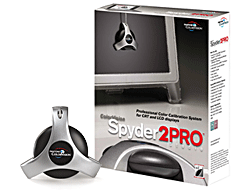 ColorVIsion Spyder2 colorimeter
ColorVIsion Spyder2 colorimeter
The prototype Spyder TV software starts with some setup instructions,
including advice on reducing the amount of light in the room. It then asks what
type of display you have (direct view, flat panel, or rear projection -- with
support for front projection targeted for the fall). Next, the software prompts
you to bring up the display's setup menu and confirm which of the five controls
are available, and then enter the scale used on the menus to measure them (e.g.,
0 to 100 on some products, or -30 to 30 on others).
The actual calibration begins by using the Spyder device to measure the
current state of the display using a black and white checkerboard pattern
displayed from the test DVD. The software prompts you to move the Spyder to the
appropriate target square on the display to take each reading. Then the software
calibrates the color temperature by taking a series of readings as you adjust
the menu to the bottom, middle, and top of the scale, and reports the proper
value for you to set.
Then the fun begins. For each control, starting with brightness, you walk
though the calibration process with the black and white targets, again starting
with the bottom, middle, and top of the scale. "And then the math takes
over," says Levey. In no more than seven more readings, the software leads
you through adjusting the setting to various points along the scale as it takes
additional measurements in order to close in on the best setting. Repeat for the
other controls (contrast, tint, and color), and you're done in around 15 to 20
minutes.
"This will be the next best thing to having a professional calibrator
come to your house," says Levey. "People care, they really do care.
It's going to deliver a marked improvement over the out of box scenario."
For users who want to delve deeper, the software then offers a
post-calibration analysis to compare the before and after settings, and display
the results with interesting test images to see the changes in areas like
highlights and shadows. Levey recommends repeating the calibration process every
four months or so to keep the display in peak form (as compared to imaging and
arts professionals who may re-calibrate their monitors monthly or even daily).
You also will need to re-calibrate after changing components, says Levey,
"or if your kid or dog goes up and changes the settings."
Datacolor is targeting shipping the Spyder TV product in June, at a price
point around $249. Based on the feedback from CES, they may have a hit -- Levey
even reports interest from video gamers at the CES conference, who were
complaining about how dark some games are: "You know that spot in Halo 2? I
always get killed there -- I can't see the guy! Will this product help?"
"He was so excited, says Levey. "These are the guys who spend
really big bucks on the graphics cards, so we'll be looking at that as
well."
This kind of growth and market expansion through acquisition is a common
thread in the growth of Datacolor, and in particular in its expansion from the
industrial market into the broader consumer / professional ColorVision product
line.
Datacolor itself is a subsidiary of Eichhof Holding AG, based in
Lucerne, Switzerland (www.eichhof.ch).
Eichhof's main business it its Eichhof Beverages division, the leading Swiss
brewer selling beers, wines and spirits, and soft drinks. As of its last annual
report for fiscal 2003/2004, the Eichhof Group had sales of approximately $240
million USD, with three major divisions: beverages ($165M), Datacolor ($65M),
and real estate ($7M).
"Eichhof was looking for business counterbalance," says Terry
Downes, CEO and president of Datacolor. "Its core beverage business was a
domestic Swiss business." Datacolor is international, and more industrial
and high-tech. "We're also more profitable, but also more volatile."
Datacolor International was formed under Eichhof in 1990, starting with Datacolor
AG in Switzerland (which Eichof already owned), and merging with two other
color technology companies: Instrument Colour Systems in the United
Kingdom, and Applied Color Systems (ACS) in Princeton. All three of these
companies had been founded around 1970 to develop color technology and
instruments.
Before Eichhof, Applied Color Systems was even owned for a time by Armstrong
World Industries, the flooring ceiling, and cabinet company. "It was part
of the corporate diversification trend of the time," says Downes. "We
were bought by one of our largest customers. But in 1989 they came under attack
by a corporate raider, and Eichhof was looking to grow its color business."
Downes holds a MS degree in chemistry and an MBA from Rider University. He
joined Applied Color Systems in 1973, and was named CEO and president of
Datacolor in 2002. The headquarters of the merged companies was originally in
Switzerland, but in 1995 it moved back to Princeton. "The critical mass was
here," says Downes, "both technology and manufacturing."
Princeton is also a good location for an international business. "Two
thirds of our customers are outside the U.S.," says Downes, "and
Princeton has good airport access, to New York and Philadelphia."
For hiring, "this environment is target rich," says Levey.
"There's a lot of good talent. We hire on a regular basis, and we've never
had a problem finding really good talent in this region, either at the
managerial level, or engineering level. On the engineering side, we're looking
for talented software engineers and scientists, with color science and visual
systems, optical engineers, electrical engineers."
"We're a short distance from RIT (Rochester Institute of Technology),
which is the wellspring of future color scientists. And there are a lot of
technical companies in this entire corridor, from Washington to Boston."
The Datacolor building is approximately 74,000 square feet, and is easy to
find because of the colorful signage and entranceway. "We built the
original section in the early 1980's as three quarters of a square (45,000
square feet)," says Downes, "and then expanded in 1990 with the
two-story section." The building currently houses approximately 110
employees. Datacolor has an additional 160 people at other sites, including 25
in the U.S., with staff in some 25 countries.
"Datacolor is a classic B-to-B company," says Levey, "serving
textile, apparel, paint, plastic, and paper industries -- wherever color is
critical in the supply chain to exacting specification, such as the interiors of
automotives, or apparel where you want to be sure your pants match your
suits." Major customers include Wal-Mart, Gap, and Ace Hardware.
Clients use Datacolor products for measuring and matching color, for example
to make sure the color is correct for a new line of dresses (or the corporate
logo), from the designer, to the dies and pigments for the raw materials, to the
manufacturer, to retail. Datacolor also supplies color communications software,
to manage the process of maintaining and verifying correct color throughout the
sourcing and manufacturing process.
Levey uses the example of the process a Wal-Mart would use to develop a new
line of clothes in a specific color. "In the past they would hire another
organization to make 5000 physical swatches of the desired color to an exacting
specification, and then send that out to die mills all over the world" for
them to qualify to manufacture the product. The mills then use Datacolor
spectrometer and quality control and formulation software to prepare samples
with the correct color. "They measure the physical swatch, create a
formulation for it, do a test sample, let it dry, and send it back by FedEx for
approval."
And this may be repeated once or twice before approval. "This entire
process, from concept to getting the product on the shelf, used to take anywhere
from 12 to 16 weeks," says Levey, "a huge amount of time. The only one
getting rich on the old process was FedEx."
With another layer of Datacolor software for color communications,
transporting physical swatches and samples can be replaced by electronic
matching of colors to the exact spectral properties. Datacolor also has software
to track and manage through the approval process, "what we call a specified
process," says Levey. "These tools enable the electronic communication
of color to supply chain specifications." And the system also ensures that
all the measurement instruments are calibrated to a master.
"This process reduces time to market by eight weeks," says Levey.
"Wal-Mart has required their suppliers to be able to use this kind of
electronic communication of color specifications."
Levey joined Datacolor in 1996 after an interesting career that took him from
a research chemist to sales and product management, with a detour as a starving
artist. He started his career working as a research chemist at Dow Chemical,
after graduating from the University of Connecticut in 1979 with a B.S. in
Chemistry.
But Levey was also interested in art. "It was always something I
did," he says. "I had a comic strip in college, and I took a couple of
art classes, but that was pretty much it." After four years with Dow,
"I took a year off to do animation and fine art."
Levey studied animation in the summer program at Sheridan College in Ontario,
Canada, but then realized "my basic skills were terrible," so he
studied fine art at Lyme Academy College of Fine Arts in Old Lyme, Connecticut.
"It raised my water level up to the point that I could actually execute the
things that were in my mind."
He then moved to New York City, "to make a living as an artist."
But, he says, "I discovered there were people who actually went to college
for four years and studied art, and not chemistry. It was fun, but I ran out of
money very quickly."
Levey's father is a marine artist in Connecticut. "I got all the
speeches about starving artists when I was living in New York City," says
Levey.
He still draws, but, he says "life takes over, and then you find you
don't do it very often. But I'll come back to it."
Levey then went to work as a sales representative for Beckman Instruments in
Allendale, New Jersey, in the laboratory automation division. "I moved up
the ranks there," he says, "into product management, sales and
marketing management, until I directed field operations. That was about a $20
million business when I left."
Levey joined Datacolor in 1996. "I liked the challenge here," he
says. "At that point Datacolor was really trying to develop a software
competency and business model. Bechman produced mission-critical software for
pharmacy QC labs, so this was something I knew a fair amount about. And the
color aspect really interested me; that mix between science, marketing, and
technology."
Levey initially served as the vice president and director of the Color
Control division, developing applications including paint-matching systems for
retail hardware stores. He then developed the plan for the new ColorVision
product line, launched in 2000 with the acquisition of technology from three
companies: Color Vision, LLC in San Diego, California (software monitor
calibration), Lucid, Inc. in Rochester, N.Y. (low cost spectrocolorimeter
hardware), and Horses LLC in New York City (printer profiling).
ColorVision was initially targeted to two types of creative professionals:
prepress professionals and professional photographers and designers. But it soon
became clear that it was the photographers who "got it immediately,"
says Levey. "They are absolutely anal about color; they love hardware
gadgets. And they were aware that these products existed, but all of them cost
two to three times what we were offering our product at."
In November 2000 ColorVision launched the first generation of the Spyder
product. "We took a hard right," says Levey, "and oriented
ourselves completely to the professional photographer market, which was unserved.
There was a need, people understood it, and the price point was great."
"We opened the photo channel with distributors like B&H," says
Levey. "We won award after award, and developed a lot of buzz."
In 2001, ColorVision began conversations with Pantone. "It started as a
meeting of both of the management teams," says Levey. "We're both in
New Jersey, and we're both in color."
"Pantone was looking to bridge the analog world of guide books and
swatches to digital," says Levey. The two companies decided to enter a
co-marketing agreement -- not a joint venture or an acquisition -- but instead
branding the products as Pantone ColorVision, with each company distributing the
products through their channels. "We continue to focus on the photography
market," says Levey, "but we found a partner that is the dominant
brand name in the designer field."
Over the next two years, says Levey, "volumes increased and we attracted
competitors." ColorVision was able to leverage its Datacolor and Eichhof
corporate relationships to add European and other overseas sales offices, reduce
costs by sourcing components in Asia, and then last year open a technology and
manufacturing center in China and a sales and support office in Hong Kong.
In March 2004, with expanding awareness of the category, ColorVision
introduced ColorPlus, its first retail box product, "to hit a $99
price point," says Levey, "that allowed us to get on the shelves in
CompUSA."
 ColorVision ColorPlus
ColorVision ColorPlus
"The conventional wisdom," says Levey, "was 'are you freaking
crazy.'" People may know what a DVD player is, what image editing software
is, but monitor calibration? "But it really had been a push-pull," he
says. "I began receiving a lot of email saying 'I looked to buy your
product at CompUSA and I couldn't find it there.'" Now ColorPlus is carried
at major retailers including Fry's on the west coast, Microcenter, J&R, and
on the Dell website.
ColorPlus is an easy-to-use product that uses the original Spyder hardware
with ColorPlus monitor calibration software to step through the process of
setting up a CRT or LCD display. It also includes Adobe Photoshop Album 2.0,
Starter Edition, and works on systems from Windows 98 to XP.
"When we launched the product we had some big concerns," says
Levey. "One was whether people would care, do they understand they have
smelly feet. The second was whether it would cannibalize our higher-end
products." Instead, the new product "immediately added a significant
unit stream to our mix," he says, "and it increased sales of higher
end products by 25 to 30 percent. Part of it was that you have customers
comparing. Every one really wants to be a pro, and now there was something to
sell off against."
"If I had only predicted that," says Levey, "I would have been
considered a bona fide marketing genius."
In September 2004, ColorVision launched the next generation of its more
advanced products, including new detectors and sensors, software and user
interfaces, and underlying algorithms for grey balance and tonal response.
"It's had phenomenal success," says Levey. "Our sales took off in
a very steep curve. When we started we were popping corks when we shipped 500
units a month. Last year we shipped about 50,000 units."
The next tier of ColorVision products are targeted to prosumers and business
professionals (i.e., professionals who are not already photographers or
artists). The products include the new Spyder2 colorimeter and calibration
software ($189), and the Spyder2 Plus bundle including the ProfilerPLUS
printer calibration software ($269).
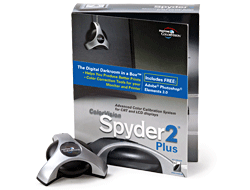 ColorVIsion
Spyder2 Plus ColorVIsion
Spyder2 Plus
For more professional calibration and support for precise tuning of profiles,
ColorVision also offers the Spyder2PRO Studio for monitor calibration
($299) and PrintFIX for printer calibration ($299, including scanner
hardware).
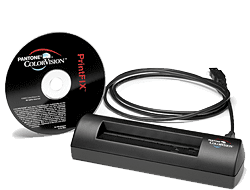 ColorVision PrintFIX
ColorVision PrintFIX
These ColorVision products support both Windows and Macintosh, and are
licensed for use in calibrating multiple monitors. ColorVision also bundles a
variety of added-value software with its various products, including Adobe
Photoshop Elements 3.0 for image editing ($89 list), Pantone Colorist
to select Pantone Matching System colors ($49), and Nik Color Efx Pro
photo filter plug-ins for Photoshop ($99).
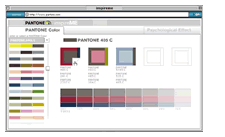 Pantone
Colorist Pantone
Colorist
ColorVision also has a higher-end professional product line, built around the
SpectroPRO monitor and printer calibration software and hardware, for
monitors, printers, and scanners (starting at $888). ColorVision also offers
Photoshop plug-ins and other tools for managing and editing calibration
profiles.
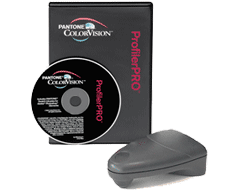 ColorVIsion SpectroPRO
ColorVIsion SpectroPRO
So it appears that C is for Color. While most consumers don't calibrate
today, they are aware that the colors on their photos look different when
printed, and that TVs can look very different. And they are getting used to
using similar picture enhancement features in DVD player software to punch up
the colors for different display types, and bring out the details in dark
movies.
"Awareness of the category has really grown," says Levey.
"Part of it is that we've been punching away at it for a long time, and
partly because we have competitors who are now adverting. After five years,
we're a force in our industry, but it was built brick by brick. And now it's the
next big thing, and the next year after that."
"In the professional sector, monitor calibration is like dental
floss," he says, "you either do it today, or you feel guilty for not
doing it. In the advanced amateur category you could probably say the same. At
the consumer level the buzz is out there, and they want to use the same tools
the pros do to get great prints."
"If you look at my career," says Levey, "the average contract
at Beckman was a half a million to a million dollars. Then at Datacolor when I
first started was it maybe $40,000 to $50,000. We were very active developing a
new retail line of paint matching systems at $5,000. And with ColorVision it's
$300 and now $99." The market is much broader; it's about
"understanding emerging trends. Having the understanding and the backing of
the company to actually put it down is very exciting."
Datacolor
www.datacolor.com
ColorVision
www.colorvision.com
Eichhof Holding AG
www.eichhof.ch
Pantone
www.pantone.com
Milori, Inc
www.milori.com
Consumer Electronics Show (CES)
www.cesweb.org
Digital Video Essentials - Joe Kane Productions
www.videoessentials.com
|
